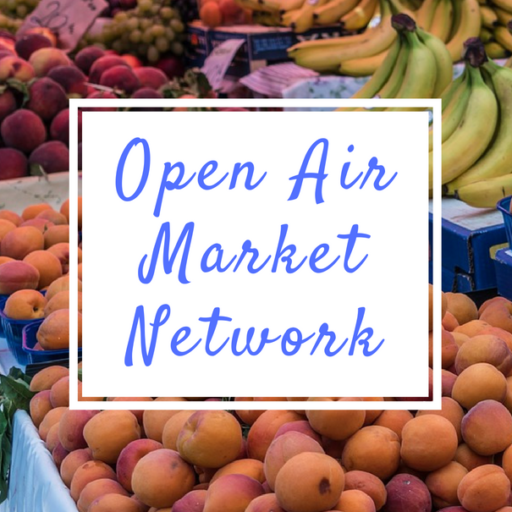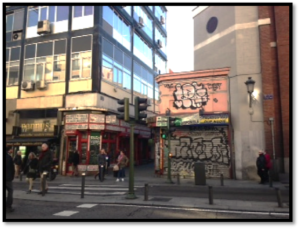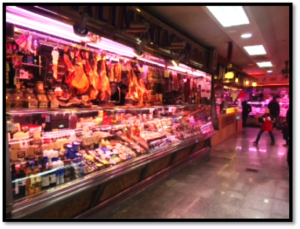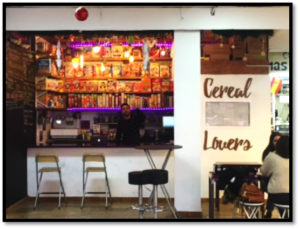By Lisa Lucas, Associate Research Specialist for Metrics + Indicators for Impact, University of Wisconsin–Madison
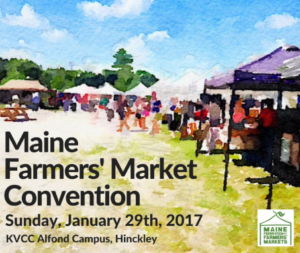 I was very excited to be able to attend and present at the Maine Federation of Farmers’ Markets (MFFM) 2017 Annual Convention yesterday, January 29. The convention was held at Kennebec Valley Community College–Alfond Campus north of Waterville, Maine. I was invited to attend along with my supervisor, Dr. Alfonso Morales of the University of Wisconsin–Madison, by MFFM’s Executive Director Leigh Hallett, whom we worked with on a project this past year.
I was very excited to be able to attend and present at the Maine Federation of Farmers’ Markets (MFFM) 2017 Annual Convention yesterday, January 29. The convention was held at Kennebec Valley Community College–Alfond Campus north of Waterville, Maine. I was invited to attend along with my supervisor, Dr. Alfonso Morales of the University of Wisconsin–Madison, by MFFM’s Executive Director Leigh Hallett, whom we worked with on a project this past year.
I loved being back in Maine. I lived in Maine briefly in 2010 before starting graduate school in New Hampshire, and my sister lived in Portland, Maine for six years before recently moving to Los Angeles. Maine is a gorgeous state! I stayed in Portland this past weekend, and enjoyed the scenic hour or so drive up to Waterville to attend the convention. Maine winters are cold, but very bright; it was nice to see sun again having come from overcast Wisconsin. But, I’ve digressed…
Alfonso was invited to give the keynote address to the over 125 market managers, farmers, and vendors from all over the state of Maine who attended; his presentation was titled “Resurgent Farmers’ Markets: Impacts Around the US and Prospects for Maine.” The gym where he presented was packed and his talk was well-received. Alfonso even packed several prizes from Wisconsin to distribute to lucky winners after his talk; how fun!
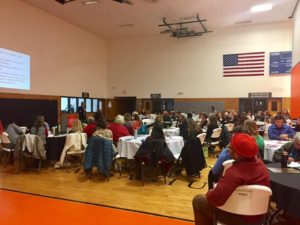
Alfonso Morales giving his keynote to a packed gym.
The schedule of the day included 13 different workshops attendees could choose from. I attended bits and pieces of several, but especially enjoyed the lively discussion in “Keep the Peace: Dealing with Difficult People on Both Sides of the Tent.” Vendors in this session shared their experiences and expertise in handling difficult vendor-vendor and vendor-customer situations. There were nods and laughs of agreement at some of the colorful stories shared!
After a delicious lunch and MFFM’s annual meeting, I presented with Leigh on data collection. Leigh discussed the results of the MFFM Snapshot Week surveys that her team distributed to shoppers at farmers markets throughout Maine last summer; they received over 2000 responses. The findings from the surveys informed the creation of MFFM’s recently published 2016 annual report which was distributed to legislators and the general public earlier this year. Among other things, the surveys showed that not only do Maine farmers market shoppers spend money at the markets they attend, they also spend an average of $20 at neighboring businesses too. Maine farmers markets are helping local economies. The Snapshot surveys also included a wealth of qualitative feedback; shoppers shared their favorite market memories and the reasons they keep coming back to their local markets. Leigh’s talk on the interesting things that data can show us was a perfect segue into my presentation on a specific data collection tool soon-to-be-available to farmers markets nationwide.
I was excited to share about Metrics + Indicators for Impact (MIFI), a comprehensive data collection, interpretation, and reporting toolkit and online portal developed by Dr. Morales and PhD candidate, Lauren Suerth, also of UW–Madison. I came to the project several months ago as a part-time project coordinator/customer service liaison supporting the work. MIFI (pronounced like “wi-fi”) is currently being pilot-tested by over 20 markets across the country. MIFI empowers markets to take data collection into their own hands. MIFI provides all the tools, directions, and support that markets will need to successfully collect data on their markets, and then an online data portal crunches the numbers behind-the-scenes. No need to hire a statistician! MIFI will be available to markets nationwide this spring, so more to come on that later.
I was very appreciative of the opportunity to travel to Maine from Janesville, Wisconsin (where I now live) to learn more about farmers markets and be able to share about MIFI, the project I’ve been working on. Thank you, Leigh! The only thing I forgot to do was grab a “lobstah” roll while I was there. Next time! (For more pictures of the event, check out the Open Air Facebook page.)
